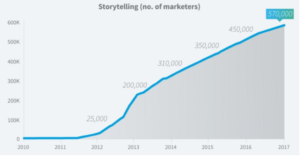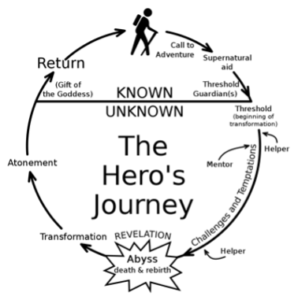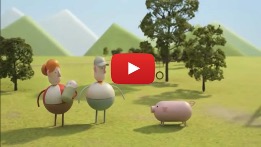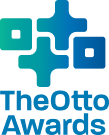Until 2010, there were virtually no self-described “storytellers” on LinkedIn. By 2013, there were 200,000. LinkedIn last calculated the amount in 2017 when the number hit 570,000.
There are two things clearly going on. First, it’s an important concept, and has some clear implications for your startup. And second, the word has become a bit of a business-world cliché. “Storytelling” strikes me as somewhat pompous. The thing is, it neatly sums up the aspirational goal for your startup communications, and I haven’t come up with a better synonym. Apparently, neither has anyone else!

So what should you think when you hear the word “storytelling”?
Let’s start with the movies-and-books type of story with which we’re most familiar. Here is the standard structure:
- We meet the hero. (In Lord of the Rings, Frodo is happy in the Shire)
- Something knocks the hero out of balance. (Frodo is given the Ring with dangerous powers)
- The hero struggles to overcome the obstacle(s) and nearly fails. (This goes on a long time…the power of the Ring nearly ruins Frodo)
- The hero finally wins and has an epiphany. (Frodo returns to the Shire and realizes the strength of his virtues)
First described in detail by professor of literature and folklorist Joseph Campbell, the concept of the “hero’s journey” as a nearly universal story structure has been studied by countless authors and screenwriters since. Here’s how Wikipedia visualizes it:

https://en.wikipedia.org/wiki/Hero%27s_journey
It’s fun to take a few of your favorite movies and realize they almost always fit it into this simple structure.
We learn to care about the hero during the journey, so we feel moved when s/he surmounts the challenge and is changed. The closing epiphany might be as banal as “family is the most important thing” (Home Alone, Finding Nemo, Honey I Shrunk the Kids etc.) but the engaging way the story was told makes the lesson resonate.
Instead of life-lesson epiphanies, the goal of business storytelling is to imbue the same powerful emotions into the action(s) you want your target audiences to take—invest, buy the product, or become an employee. The path to get there may be shorter, but conceptually, the structure is the same.
These are the three foundational stories most startups need to create:
Audience-specific:
- Why and how we will improve your life (customers)
- How and why we are building something huge (investors)
- Why who we are is great, and why our mission is great (the brand story)
Those are the outcomes—now we need to build the text to get the target audience to notice. You’ll notice none of these are “what” (ie boring facts), but rather “why” and “how” (emotions & aspirations). The story answering each contains versions of the hero’s journey.
Let’s look at each:
The Customer Story
What motivates customers is not the list of features your product has, it is what benefits the customer will get from purchasing your product. You don’t purchase a camera because it has a certain number of megapixels (the feature), you purchase a camera to unleash your inner artist (the customer benefit). So this “story” can be quite short: As long as you vividly describe how your product will help your customer live a fulfilling life, it can be as short as a headline and image. You can of course build a whole narrative around this. If you sell riding lawnmowers, you might promote the idea that your machine will help the homeowner be the hero of his suburb and proud king of his household (allow me the gender-specificity here for a product I feel is usually targeted at men). Depending on space and medium, you can build a story around this involving a jealous neighbor or an eye-rolling teenager, but it might end with the hero fulfilled as a result of the beautiful lawn and impressed spouse. When you’re selling a deep-tech innovation in the semiconductor industry, you may have more limited room for a “story,” but the key fact remains: Describe your product in terms that emphasize the benefits and fulfilment the customer receives. Keep your hero (customer) firmly in mind as you write.
The Investor Story
Every founder has had some version of pitch deck structure drilled into them. Most templates focus on the number of pages and the specific content each should have (“Problem,” “Solution,” “Team” etc.) Those aren’t wrong, but they’re missing the story arc that not only holds the pitch together but provides a framework in the minds of the audience for them to remember the key facts later. Here are a few brief examples of narrative frameworks that can provide structure to your pitch deck:
- Massive Societal Shift: A large trend is creating a new market; here’s what others are missing; our insight yielded this solution
- Massive Market: There’s overwhelming opportunity in this burgeoning field, but the following problem; We have a fresh solution
- Groundbreaking Invention: An existing problem has been solved by our new invention
- Already Taking Off: We built this thing and suddenly everybody wants it; traction story
Each one dictates a certain order in which you would present your slides and facts. Importantly, they each provide different opportunities for you to showcase the two key features of every successful investor pitch: a huge opportunity and a great team. The co-founders are the heroes overcoming the problem or inefficiency you’ve identified in the marketplace. If you present those two pieces within the arc of a narrative, you might successfully transport the audience from indifference to check-writing.
The Brand Story
This one can come in a few flavors, including the founding myth and a longer description of the mission. It can be as simple as the About paragraph on a simple one-page website. A founder’s journey, which you can think of as the brand story of an individual, might include the following beats (note the similarity to the hero’s journey):
- I was living my life, oblivious (I was earning good money as a stock analyst)
- Something knocked me off course (I was suddenly struck by this mysterious illness)
- It nearly ruined me but I prevailed (I was very sick for months until I discovered a cure)
- I’ve discovered my new mission (I’m now helping everyone who has the same condition)
A simple story about the company depends on building up the size and importance of the problem you’re solving before you ride to the rescue. The bigger the ogre, the more of a hero you are for slaying it.
If you have the space or ability to tell a longer story, you can start to illustrate the impact that your company has for your customers, society, and the world. Tell the story of a teenager released from the horror of middle-school acne by your face cream or the story of a fish struggling in a poisoned river before your solution cleans it up. Whether your company is solving a problem or offering an improvement, there is life before and life after. Watch this classic Chipotle brand story spot below. Now that you know the beats of the hero’s journey, identifying the structure becomes easy:

The entrepreneurs who nail one or more of these are what makes unicorns (and win Otto Awards!) But anyone can benefit from learning these principles. Many startups, particularly at the early stage, and/or working in a wonky B2B segment, might not need to tell a big ‘cinematic’ story—but keeping the key structures in mind will help you even as you craft a simple landing page website.
